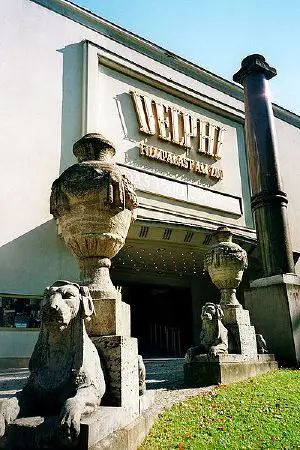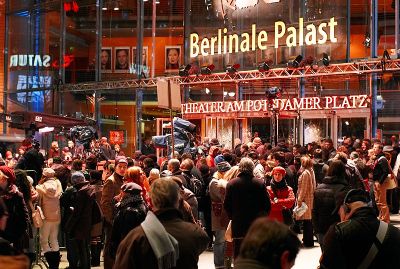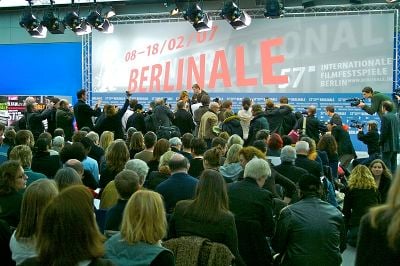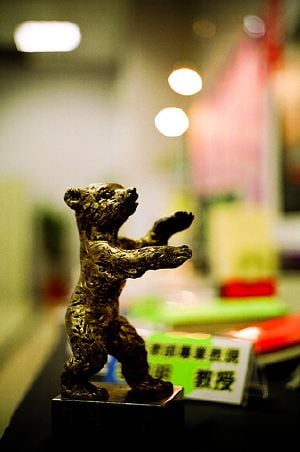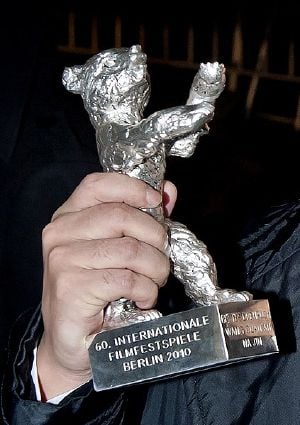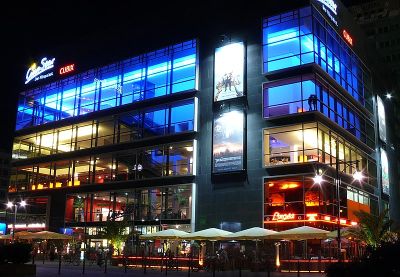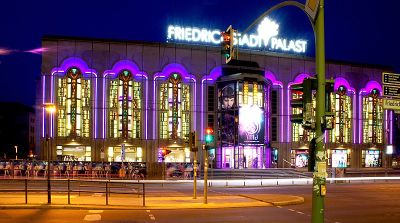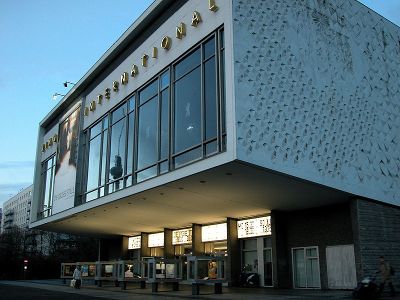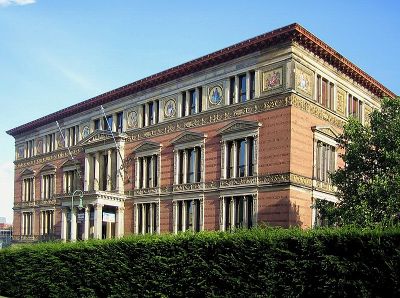Berlin International Film Festival

| |
| Location | Berlin, Germany |
|---|---|
| Founded | 1951 |
| Awards | Golden Bear, Silver Bear |
| Artistic director | Carlo Chatrian |
| Website | Berlin International Film Festival |
The Berlin International Film Festival (German: Internationale Filmfestspiele Berlin), usually called the Berlinale (German pronunciation: [bɛʁliˈnaːlə]), is a film festival held annually in Berlin, Germany. Founded in 1951 and originally run in June, the festival has been held every February since 1978 and is one of the "Big Three" alongside the Venice Film Festival in Italy and the Cannes Film Festival in France.
With tens of thousands if visitors attending each year, it is one of the largest film festivals in the world. About 400 films are shown in several sections across cinematic genres. Around twenty films compete for the festival's top awards, called the Golden Bear and several Silver Bears.
History
the festival has been held every February since 1978 and is one of the "Big Three" alongside the Venice Film Festival in Italy and the Cannes Film Festival in France.[1]
First festival
During the peak of the Cold War in 1950, Oscar Martay, a film officer of the Information Service Branch of the American High Commissioner for Germany stationed in Berlin, proposed the idea of a film festival in Berlin.[2] The proposal was put through a committee, which included members of the Senate of Berlin and people from the German film industry, on 9 October 1950. Through his efforts and influence, the American military administration was persuaded to assist and to give loans for the first years of the Berlin International Film Festival, which commenced in June 1951. Film historian Dr. Alfred Bauer was the festival's first director, a position he would hold until 1976.[3]
Alfred Hitchcock's Rebecca opened the first festival at the Titiana-Palast in Steglitz on June 6, 1951. The festival ran from June 6 to 17, with Waldbühne being another festival venue.[3]
The winners of the inaugural awards in 1951 were determined by a West German panel, and there were five winners of the Golden Bear, the prize for best film, divided by categories and genres. Disney's Cinderella, which won the Golden Bear for a Music Film, also won the audience award.[4]
Early years and awards
The FIAPF (Fédération Internationale des Associations de Producteurs de Films) prohibited the awarding of prizes by an expert jury, which is reserved for "A-status" accredited festivals, so between 1952 and 1955 the winners of the Golden Bear were determined by the audience members.[3] In 1956, FIAPF formally accredited the festival and since then the Golden Bear has been awarded by an international jury.[5]
During the Cold War, a selection of the films were also screened in East Berlin.[6]
1970s
The 20th Berlin International Film Festival in 1970 was cut short and awards not issued following controversy over the showing of Michael Verhoeven's anti-war film o.k..[7] The jury, headed by American film director George Stevens, decided after a 7–2 vote to remove the film from the competition, justifying their decision by citing a FIAPF guideline that said: "All film festivals should contribute to better understanding between nations." Stevens claimed that the film, which includes a gang rape of a Vietnamese woman by American soldiers during the Vietnam War, was anti-American.[8] One jury member, Dušan Makavejev, protested against this measure, standing up for the film and supporting Verhoeven and producer Rob Houwer.[9] Verhoeven defended his film by stating in these terms: "I have not made an anti-American film... The biggest part of the American people today is against the war in Vietnam".[10] Other directors taking part in the festival withdrew their films in protest, and the jury was accused of censorship and eventually disbanded, so no prizes were awarded and the competition was suspended.[11]
This scandal had such a major impact that the future of the festival was in doubt. Festival director Alfred Bauer resigned and it was clear that the festival needed to take a new direction if it was to continue.[9] Bauer returned and the following year, the festival was re-formed and a new International Forum for New Cinema was created.[12]
Wolf Donner took over the directorship in 1976, and he gave German films higher priority.[13] After his first Berlinale in June 1977, Donner successfully negotiated the shift of the festival from the June to February (February 22 – March 5, 1978), a change which has remained ever since.[8]
The 28th Festival, held in 1978, saw the jury award the Golden Bear to Spain for its contribution to the festival rather than a specific film.[7] The three Spanish films which were screened at the festival and won were short film Ascensor directed by Tomás Muñoz and feature films La palabras de Max by Emilio Martínez Lázaro and Las truchas by José Luis García Sánchez.[14] The 1978 festival also saw the start of the European Film Market.
1980–2000
After only three years in the role, Donner was followed by Moritz de Hadeln, who held the position from 1980[15] until director Dieter Kosslick took over in 2001.[16]
Twenty-first century
A new Series section, devoted to longform television series, was introduced in 2015.[17]
In June 2018, it was announced that Mariette Rissenbeek would serve as the new executive director alongside artistic director Carlo Chatrian. They assumed their posts after Kosslick's final edition in 2019. Rissenbeek became the first woman to lead the Berlinale.[18][19]
A shortened 71st festival took place virtually in March 2021, due to the COVID-19 pandemic. An open air summer event was planned as well.[20]
Festival program
The festival is currently composed of nine different sections:[21]
- Competition: The centerpiece of the Berlinale, feature-length films yet to be released outside their country of origin compete for several prizes, including the top Golden Bear for the best film and a series of Silver Bears for acting, writing, and production.[22]
- Berlinale Special: A diverse selection of films, events and people, and Berlinale Series for television series.[17]
- Encounters: Established in 2020 to foster "daring works" when Culinary Cinema was dropped.[23]
- Berlinale Shorts: A separate section for short films since 2007; short films were honored with Golden and Silver Bears from 1955, with a separate jury for shorts established in 2003.[24]
- Panorama: Extraordinary cinema: "explicitly queer, explicitly feminist, explicitly political ... always looking for what is new, daring, unconventional and wild in today’s cinema" cinema.[25]
- Forum & Forum Expanded: Reflections on the medium of film; a selection of around 40 films, independently curated and organized by Institut für Film und Videokunst (Arsenal Institute for Film and Video Art) as part of the Berlinale, since 1971.[26]
- Generation: Comprising Generation Kplus and Generation 14plus, two competition programs screening international cinema exploring the worlds of children and teenagers; started in 1978 with a selection "Cinema for People Six and up"; then Kinderfilmfest ("Children’s Film Festival"); expanded to include the 14plus competition in 2004; renamed Generation in 2007, with the two sections.[27]
- Perspektive Deutsches Kino: Perspectives on German Cinema, created in 2002 by incoming director Dieter Kosslick with Alfred Holighaus[28]
- Retrospective, Berlinale Classics & Homage: Berlinale’s film history program established in 1977. Curated by the Deutsche Kinemathek – Museum für Film und Fernsehen the Retrospective brings works from international film history back to the big screen. In Berlinale Classics, digitally restored film classics and rediscoveries celebrate their premieres. the Homage honors outstanding personalities from the international film scene, screening their most important works in a series of films. The presentation of the Honorary Golden Bear for a lifetime’s achievement at a gala screening in the presence of the honored guest is one of the highlights of the Berlinale.[29]
Awards
The Golden Bear (Goldener Bär) is the highest prize awarded for the best film at the Berlin International Film Festival. In its first year in 1951 there were five winners of the Golden Bear, divided by categories and genres, awarded by a German jury.[30]
From 1952 to 1955 the Golden and Silver Bears were awarded by audience voting, as the FIAPF had determined after the first festival that only Cannes and Venice Film Festivals were allowed to appoint official juries.[31] In 1956, the Fédération Internationale des Associations de Producteurs de Films formally accredited the festival, and since then, the Golden Bear has been awarded by an international jury.[5]
A Silver Bear (Silberner Bär) and a Bronze Berlin Bear, determined by audience vote, were awarded from 1952 to 1955.[32][33]
International jury prizes
Since 1956, the jury of the Festival has been chaired by an internationally recognized personality of cinema.[34]
The main prizes in the festival are those awarded by the international jury since 1956, which today include the Golden Bear and various Silver Bears.[35] In 1956, apart from the Golden Bear, there were also Silver Bears awarded by the new international feature film jury for best director, best actress, best actor, best outstanding single achievement, outstanding artistic contribution, and an Silver Bear International Prize.[36]
The statuettes awarded as trophies are based on the Bär first created by sculptor Renée Sintenis (1888–1965) in 1932. The bear, based on the coat of arms of Berlin and depicting a bear standing on its hind legs with its arms raised, became popular in the 1930s, bringing wealth to Sintenis. Since the 3rd edition of the festival in 1953, replicas of the bear have been produced by the Noack Foundry.[37][38]
- Golden Bear
The Golden Bear for Best Film is awarded to the producers of the best feature film.[35]
The Golden Bear (German: Goldener Bär) is the highest prize awarded for the best film at the Berlin International Film Festival. The bear is the heraldic animal of Berlin, featured on both the coat of arms and flag of Berlin.
The statuette shows a bear standing on its hind legs and is based on the 1932 design by German sculptor Renée Sintenis of Berlin's heraldic mascot that later became the symbol of the festival. It has been manufactured since either the first[39] or third[40] edition by art foundry Hermann Noack.[41]
It original award was redesigned in a larger version in 1960,[42] with the left arm of the bear was raised as opposed to the right in the former model.[43]
The bear is 20 centimeters (7.9 in) high and is fixed onto a base where the winning name is engraved.[44] The figurine consists of a bronze core, which is then plated with a layer of gold. The total weight of the award is 4 kilograms (8.8 lb).[45]
- Silver Bear
The categories of Silver Bear awards are:[35]
- Silver Bear Grand Jury Prize
- Silver Bear Jury Prize
- Silver Bear for Best Short Film
- Silver Bear for Best Director
- Silver Bear for Best Leading Performance
- Silver Bear for Best Supporting Performance
- Silver Bear for Best Screenplay
- Silver Bear for Outstanding Artistic Contribution
Other Berlinale awards
The Honorary Golden Bear has been awarded for lifetime achievement since 1982, when it was awarded to James Stewart.[46][47] It is presented to someone with an exceptional artistic career, and is given to the guest of honour of the Homage section[48] which has been run since 1977 by the Berlinale and the Deutsche Kinemathek – Museum für Film und Fernsehen.[29]
Awards for short films are awarded by a separate international short film jury consisting of three filmmakers and artists. As of 2022 the short film award are:[49]
- Golden Bear for Best Short Film (since 1956)
- Silver Bear Jury Prize (Short Film)
- Berlin Short Film Candidate for the European Film Awards
There are also awards given by separate juries or via other routes at the Berlinale. These include:
- The Berlinale Camera has been awarded since 1986, with the trophy modelled on a real camera, made with 128 parts, some movable. It is awarded to "personalities and institutions that have made a unique contribution to film", as a way for the festival to express its thanks to friends and supporters of the festival. Past winners include Isabella Rossellini, Michael Ballhaus, Claude Chabrol, Jodie Foster, Otto Sander, Karlheinz Böhm, Clint Eastwood, Gina Lollobrigida, Sydney Pollack, and Curt Siodmak.[38]
- Crystal Bears (Gläserner Bär), Grand Prix and special prizes are awarded in the Generation section (grouped separately into Generation Kplus and Generation 14plus)[50]
- GWFF Best First Feature Award (since 2006), worth 50,000 Euros, is funded by Gesellschaft zur Wahrnehmung von Film- und Fernsehrechten.[51]
- Three prizes are awarded in the Encounters section (since 2020).[52]
- Berlinale Documentary Award (since 2017), worth 40,000 Euros, sponsored by public broadcaster Rundfunk Berlin-Brandenburg (rbb), with entries from the Competition, Encounters, Panorama, Forum, Generation, Berlinale Special and Perspektive Deutsches Kino sections.[53]
- Panorama Audience Award, established in 1999[54]
- Compass-Perspektive-Award, for the best film in the current Perspektive Deutsches Kino program[54]
- Readers' awards, one each by Berliner Morgenpost and Tasspiegel, and the Teddy Readers' Award[54]
- Several development awards[54]
Independent awards
The Shooting Stars Award for young European acting talent is independently awarded by European Film Promotion at Berlinale Palast.[55]
There are also many other prizes given by independent juries (not connected to the Berlinale) at the event. These include, among others:
- FIPRESCI awards for best film in each of the Competition, Encounters, Panorama and Forum sections[54]
- Teddy Awards, for films with LGBT topics[54]
- Prize of the Ecumenical Jury, since 1992[54]
- Amnesty International Film Award, since 2005[54]
- Peace Film Prize[54]
Former awards
- Silver Bear for Best Actor (1956–2020) (replaced by Best Leading and Supporting Performance)
- Silver Bear for Best Actress (1956–2020) (replaced by Best Leading and Supporting Performance)
- Silver Bear for Outstanding Single Achievement (1956–2005, occasional)[56]
- Silver Bear for Special Artistic Achievement (1956–2007, occasional) (replaced by Silver Bear for Outstanding Artistic Contribution)[57]
- Silver Bear for Film Music (2002–2007)[58]
- Alfred Bauer Prize (1987-2020) (replaced by Silver Bear Jury Prize, after it came to light that the role played by Berlinale founding director Alfred Bauer in the Reichsfilmintendanz (Reich Film Office) during Nazi times was more substantial than had previously been realised, and had been covered up by Bauer after the war)[59]
- Cinema Fairbindet, an award given by Germany's Federal Ministry for Economic Cooperation and Development (BMZ) at the festival between 2011 and 2014[60][61]
Venues
The Theater am Potsdamer Platz, a theatre for musicals which is known as the Berlinale Palast during the festival, is the venue for the premieres of Competition film and several Special Gala films, as well as the opening and awards ceremonies.[62]
The CinemaxX Potsdamer Platz, which has 19 screens, has been the main Berlinale screening cinema since 2000, two years after its opening in 1998.[63]
Other venues for the festival include or have included the following:[64]
- The first festival was screened at the Titiana-Palast in Steglitz, as well as the open-air cinema at Waldbühne, in June 1951.[65][66][67] The Titiana Palast building, dating from 1926, still bears this name on a sign outside, but as of 2022 is known as the Cineplex Titania. It was renovated in 2014, creating seven cinemas with over 1,200 seats, along with 7.1 Dolby Digital sound technology.[68][69]
- The historic Delphi Filmpalast am Zoo (aka the Delphi; built on the site of an old dance hall, was opened in 1949 by Walter Jonigkeit.[70][71] It is located near the Berlin Zoologischer Garten and has been used for the festival almost since its inception. Since 1981 it has been one of the main venues for the Forum programme, maintaining its old style as a picture palace.[70] In 2015 the stalls seating was replaced, reducing the number of seats by 114 and improving spacing and comfort.[72] Seating an audience of up to 673 people, it is one of Germany’s biggest independent screens. In February 2022, ready for the 72nd edition of the festival, a state-of-the-art Christie CP4440-RGB laser cinema projector was installed.[73]
- The Zoo Palast was built in 1957 to designs by cinema architect Gerhard Fritsche, and opened with the film Die Zürcher Verlobung, starring Liselotte Pulver, who also cut the ribbon in the opening ceremony.[74] It was purpose-built for the festival. It remained the home of the festival Until 1999, and was the venue for films premeiering in competition. It closed from 2011 until late 2013 for a complete interior reconsruction and renovation, opening in time for the 2014 festival with seven cinemas and offering a total of 1,650 seats, and space for 791 in the main auditorium.[75] The renovations were designed by architect Anna Maske. Liselotte Pulver again reopened the cinema after renovations in 1994 and 2013.[74]
- The exhibition space and screening hall of the Academy of Arts (Akademie der Künste) in the Tiergarten district was used as a venue before the Berlinale moved its main activities to Potsdamer Platz in 2000. It was briefly a venue for the for the Forum program from 2015, and once again took on duties as screening venue after the closure of the Sony Center at the end of 2019.[76][77]
- The eight-screen CineStar Sony Center,[78] and later the adjoining CineStar IMAX,[79] both located in the Sony Center at Potsdamer Platz, were venues until the closure of the Sony Center at the end of 2019.[76]
- In 2007, the CineStar CUBIX multiplex cinema (Cubix am Alexanderplatz,[80] styled CUBIX[81]), which opened in November 2000, started screening films for the festival on three of its screens.[79][82] From 2020, after the closure of the Sony Center, the festival expanded its use of CineStar CUBIX to use all nine screens.[76]
- The Kino Babylon was a Berlinale venue from 2008 (when it hosted its new "Generation14plus" event[83][84]) to 2010,[85] but has not been listed as such since 2011.[86][87][78][64]
- Since 2009, Friedrichstadt-Palast has also been used. This venue not only has the largest theatre stage in the world, but the biggest cinema of the film festival, with 1,635 seats available for screenings. Films from the Competition and Berlinale Special Gala sections are shown at Friedrichstadt-Palast, and a digital 4K laser projector is supplied for the festival.[88]
- The historic Kino International, built in the 1960s to the designs of GDR architect Josef Kaiser, is an example of GDR Modernism.[89] It has been one of the venues for the Berlinale since sometime in the mid-2010s,[78][79] accommodating an audience of 555 people (originally built for 600).[89][90]
- The Kino Arsenal at the Arsenal Institute for Film and Video Art (formerly known as Friends of the German Film Archive until 2008) in Potsdamer Strasse is the main venue of the Forum event. The original Arsenal, in Welserstraße in Berlin-Schöneberg, was where this section was born. In 1999, Arsenal moved with Friends of German Film Archive, German Film Museum and the German Film and Television Academy Berlin into the Filmhaus on Potsdamer Platz. There are two screens here, with seating for 235 and 75.[91][92]
- The Haus der Kulturen der Welt, in the middle of Tiergarten Park, is the venue for the premieres of Generation, the youth section of the festival.[93]
- Urania Berlin is used for film premieres in the Generation section.[94]
- The Zeiss Major Planetarium is a planetarium, which has two spaces available for film screenings, the planetarium hall with 307 seats, and a cinema hall with 160 seats. It was one of the last buildings built in the GDR, constructed in 1987.[95]
Other venues in use as of 2022 include the Akademie der Künste; the Marshall McLuhan Salon at the Canada House; Brotfabrik; City Kino Wedding at the Centre Francais; Deutsche Kinemathek; Eva Lichtspiele; Filmtheater am Friedrichshain; Hebbel am Ufer (HAU); Kino Intimes; Neue Kammerspiele; Passage Kino; SAVVY Contemporary; Silent Green Kulturquartier; Kino Union; and the Zeughauskino (in the Deutsches Historisches Museum).[64]
Related events
The European Film Market (EFM), a film trade fair held simultaneously to the Berlinale, is a major industry meeting for the international film circuit.[96] The trade fair serves distributors, film buyers, producers, financiers and co-production agents. The Berlinale Talents, a week-long series of lectures and workshops, is a gathering of young filmmakers held in partnership with the festival.[97]
European Film Market
The European Film Market (EFM) is a large trade fair for marketing films, which grew from an event started in 1978.[65] Filmmesse was an event led by Aina Bellis from 1980 to 1987, being succeeded by Beki Probst in 1988. From 2014 to October 2020, Matthijs Wouter Knol took over the position. In November 2020, Dennis Ruh became the director of the EFM.[98]
It has grown into one of three largest movie markets in the world, and is the first film market of the year;[99] the Marché du Film in Cannes follows in May, and the American Film Market in November.[citation needed]
EFM provides exhibition space for companies presenting their current line-up, organising screenings of new films in venues around Potsdamer Platz. In 2007, the CinemaxX and CineStar were used to showcase new productions. In 2010, the Astor Film Lounge showed market screenings in three dimensions using digital RealD technology.[citation needed]
It is a professional trade event, open to registered industry insiders, hosting up to 10,000 representatives of the international film and media industries (mostly producers, sales agents, distributors and financiers).[99] In 2020, 971 screenings of 732 registered movies took place, with 525 films celebrating their premiere.[100] Taking place over eight days, the event is spread across several locations, including the Gropius Bau, Marriott Hotel, modern Berliner Freiheit or the historic Zoo Palast.[99]
Berlinale Talents
Commencing in 2003, the Berlinale has partnered with the Berlinale Talents (previously Berlinale Talent Campus), which is a winter school for "up-and-coming filmmakers" that takes place at the same time as the festival. The Talent Campus accepts about 250 applicants each year; the attendees come from around the world, and represent all of the filmmaking professions.[101]
The event runs six days during the Berlinale and features lectures and panel discussions with well-known professionals addressing issues in filmmaking. Workshops, excursions, personal tutoring, coaching, and training of participants from different fields of work are part of the programme.
The proceedings include presentations by experts.[102] Many of these presentations and lectures are archived, both as video recordings and as transcripts, on the Talents website.[103]
Berlinale Co-Production Market
The Berlinale Co-Production Market is a five-day networking platform for producers and financiers, as well as broadcasting and funding representatives who are participating in international co-productions.[104]
World Cinema Fund
The World Cinema Fund (WCF) was established by Dieter Kosslick[105] in 2004. It is associated with the Berlinale to provide financial support to feature film projects in countries in countries with weak film infrastructure thereby helping strengthen the regions’ position on the international film market.[106]
The WCF is a collaboration with the Federal Foundation for Culture, and awarded in cooperation with the Goethe Institute, the Foreign Ministry and German producers. It aims "to develop and support cinema in regions with a weak film infrastructure, while fostering cultural diversity in German cinemas."[107] It provides funding for production and distribution of feature films and feature-length documentaries, with a focus on countries in Latin America, Central America, the Caribbean, Africa, the Middle East, Central Asia, Southeast Asia, and the Caucasus, as well as Bangladesh, Nepal, Mongolia, and Sri Lanka.
Notes
- ↑ Marijke de Valck, Brendan Kredell, and Skadi Loist (eds.), Film Festivals: History, Theory, Method, Practice (Routledge, 2016, ISBN 978-0415712477).
- ↑ Cindy H. Wong, Film Festivals: Culture, People, and Power on the Global Screen (Rutgers University Press, 2011, ISBN 978-0813551210).
- ↑ 3.0 3.1 3.2 1st Berlin International Film Festival June 6-17, 1951 Berlinale. Retrieved September 28, 2022.
- ↑ Prizes & Honours 1951 Berlinale. Retrieved September 28, 2022.
- ↑ 5.0 5.1 Juries 1952 Berlinale. Retrieved September 28, 2022.
- ↑ Harold Myers, Berlin Film Fest Unreeling Variety, June 29, 1960. Retrieved September 28, 2022.
- ↑ 7.0 7.1 Berlinale beginnings Variety, February 8, 2012. Retrieved September 28, 2022.
- ↑ 8.0 8.1 Michelle Langford, Directory of World Cinema: Germany (Intellect Ltd, 2012, ISBN 978-1841504650).
- ↑ 9.0 9.1 20th Berlin International Film Festival, June 26 - July 7, 1970 Berlinale. Retrieved September 28, 2022.
- ↑ War film dropped by Berlin Festival The New York Times, July 4, 1970. Retrieved September 28, 2022.
- ↑ Berlinale looks back on 60 years of war, scandal and glamour Deutsche Welle, February 10, 2010. Retrieved September 28, 2022.
- ↑ 21st Berlin International Film Festival June 26 - July 6, 1971 Berlinale. Retrieved September 28, 2022.
- ↑ 27th Berlin International Film Festival June 24 - July 5, 1977 Berlinale. Retrieved September 28, 2022.
- ↑ Prizes and Honors 1978 Berlinale. Retrieved September 28, 2022.
- ↑ 30th Berlin International Film Festival February 18 - 29, 1980 Berlinale. Retrieved September 29, 2022.
- ↑ 51st Berlin International Film Festival February 7 - 18, 2001 Berlinale. Retrieved September 29, 2022.
- ↑ 17.0 17.1 Berlinale Special & Berlinale Series Berlinale. Retrieved September 29, 2022.
- ↑ Leo Barraclough, Mariette Rissenbeek, Carlo Chatrian to Become Co-Chiefs of Berlin Film Festival Variety, June 22, 2018. Retrieved September 29, 2022.
- ↑ Matt Mueller, Berlin Film Festival's new co-chief Mariette Rissenbeek on her appointment and future plans Screen Daily, August 2, 2018. Retrieved September 29, 2022.
- ↑ Berlinale 2021 Will Be a Festival in Two Stages: Industry Online Offer in March / Public Event in June Berlinale, December 18, 2020. Retrieved September 29, 2022.
- ↑ Sections & Special Presentations Berlinale. Retrieved September 30, 2022.
- ↑ Competition Berlinale. Retrieved September 30, 2022.
- ↑ Encounters Berlinale. Retrieved September 30, 2022.
- ↑ Berlinale Shorts Berlinale. Retrieved September 30, 2022.
- ↑ Panorama Berlinale. Retrieved September 30, 2022.
- ↑ Forum & Forum Expanded Berlinale. Retrieved September 30, 2022.
- ↑ https://www.berlinale.de/en/festival/sections/generation.html Generation] Berlinale. Retrieved September 30, 2022.
- ↑ Perspektive Deutsches Kino Berlinale. Retrieved September 30, 2022.
- ↑ 29.0 29.1 Retrospective, Berlinale Classics & Homage Berlinale. Retrieved September 30, 2022.
- ↑ Prizes & Honours 1951 Berlinale. Retrieved September 30, 2022.
- ↑ Juries 1953 Berlinale. Retrieved September 30, 2022.
- ↑ Prizes & Honours 1952.
- ↑ Prizes & Honours 1955.
- ↑ Juries 1956.
- ↑ 35.0 35.1 35.2 Prizes of the International Jury (16 February 2022).
- ↑ Prizes & Honours 1956.
- ↑ François, Emmanuelle (2 March 2018). The woman behind the Bär.
- ↑ 38.0 38.1 Berlinale Camera.
- ↑ Eventful Berlinale (February 19, 2020).
- ↑ François, Emmanuelle (2 March 2018). The woman behind the Bär.
- ↑ "German Film Festival bear awards based on 1939 design previewed in Berlin", EFE, January 11, 2019.
- ↑ Große kleine Tiere (in de). Cicero.
- ↑ English, James F. (2008). The Economy of Prestige: prizes, awards, and the circulation of cultural value. Cambridge, Massachusetts: Harvard University Press, 167–168. ISBN 978-0-674-03043-5.
- ↑ Günther, Ulrich, "Berlinale Cineasten blicken auf den Bären", Frankfurter Allgemeine Zeitung, February 19, 2010. (written in de)
- ↑ In pictures. Novinite (February 8, 2010).
- ↑ Prizes & Honours 1982.
- ↑ The Honorary Golden Bear. Internationale Filmfestspiele Berlin.
- ↑ The Honorary Golden Bear.
- ↑ Prizes of the International Short Film Jury.
- ↑ Awards and Juries in the Generation section.
- ↑ GWFF Best First Feature Award.
- ↑ Awards in the Encounters section.
- ↑ Berlinale Documentary Award.
- ↑ 54.0 54.1 54.2 54.3 54.4 54.5 54.6 54.7 54.8 Further Prizes.
- ↑ European Shooting Stars (13 January 2022).
- ↑ Archive search [single achievement].
- ↑ Archive search [artistic achievement].
- ↑ Archive search [film music].
- ↑ The Alfred Bauer case.
- ↑ New in distribution – Road show "Cinema fairbindet".
- ↑ Concerning Violence.
- ↑ Festival Map: Berlinale Palast.
- ↑ Festival Map: CinemaxX Potsdamer Platz.
- ↑ 64.0 64.1 64.2 Festival Map.
- ↑ 65.0 65.1 Cite error: Invalid
<ref>tag; no text was provided for refs namedbeginnings - ↑ Cite error: Invalid
<ref>tag; no text was provided for refs namedOscar Martay - ↑ Waldbühne open-air stage.
- ↑ Festival Map: Cineplex Titania.
- ↑ Du bist mein Kino! (in de).
- ↑ 70.0 70.1 Festival Map: Delphi Filmpalast.
- ↑ Delphi – Filmpalast am Zoo.
- ↑ Kohzer, Benjamin. Delphi Filmpalast am Zoo Berlin (in de).
- ↑ Delphi Filmpalast Berlin Invests in Christie RGB Pure Laser Projection (9 February 2022).
- ↑ 74.0 74.1 Kohzer, Benjamin. Zoo Palast Kino Berlin (in de).
- ↑ Festival Map: Zoo Palast.
- ↑ 76.0 76.1 76.2 Blaney, Martin (9 January 2020). Berlinale 2020 adds screening venues in the wake of closures.
- ↑ Festival Map: Akademie der Künste (Hanseatenweg).
- ↑ 78.0 78.1 78.2 - Berlinale - Programme - Venues - Cinemas.
- ↑ 79.0 79.1 79.2 Berlinale venues. Berlin International Film Festival.
- ↑ CineStar Cubix am Alexanderplatz - Kinobeschreibung und Termine - Kinoprogramm für Berlin und Umland (in de).
- ↑ CineStar CUBIX am Alexanderplatz, Berlin.
- ↑ Festival Map: CUBIX.
- ↑ Blaney, Martin (3 November 2008). Berlinale expands eastwards with new venue for 2009.
- ↑ Berlinale 2008: First titles selected for the Generation section. Babylon is new venue (18 December 2007).
- ↑ 59th Berlin International Film Festival: February 5 - 15, 2009.
- ↑ Tempest, Matthew (12 July 2011). Cine-files: Babylon, Berlin.
- ↑ Berlin 2010.
- ↑ Festival Map: Friedrichstadt-Palast.
- ↑ 89.0 89.1 Kino International.
- ↑ Festival Map: Kino Internatioal.
- ↑ Festival Map: Kino Arsenal.
- ↑ Über uns (in de).
- ↑ Festival Map: Haus der Kulturen der Welt.
- ↑ Festival Map: Urania.
- ↑ Festival Map: Zeiss Planetarium.
- ↑ Berlin Film Festival a market force {{#invoke:webarchive|webarchive}}, Variety, 13. February 2008
- ↑ Berlin Talent campus wins hearts {{#invoke:webarchive|webarchive}}, fest21.com
- ↑ Filmmarkt mit neuer Leitung.
- ↑ 99.0 99.1 99.2 Profile (9 September 2022).
- ↑ Facts & Figures - European Film Market.
- ↑ Berlinale Talents {{#invoke:webarchive|webarchive}}, berlinale-talentcampus
- ↑ Talent Campus adds to lineup {{#invoke:webarchive|webarchive}}, Variety
- ↑ Berlinale Talents (in en-GB).
- ↑ Profile Berlinale Co-Production Market.
- ↑ Cite error: Invalid
<ref>tag; no text was provided for refs namedchange - ↑ Florentina Bratfanof, Understanding the Berlinale - An insider's diary ASEF culture360, April 3, 2013. Retrieved September 30, 2022.
- ↑ World Cinema Fund Retrieved September 30, 2022.
ReferencesISBN links support NWE through referral fees
- de Valck, Marijke, Brendan Kredell, and Skadi Loist (eds.). Film Festivals: History, Theory, Method, Practice. Routledge, 2016. ISBN 978-0415712477
- Langford, Michelle. Directory of World Cinema: Germany. Intellect Ltd, 2012. ISBN 978-1841504650
- Wong, Cindy H. Film Festivals: Culture, People, and Power on the Global Screen. Rutgers University Press, 2011. ISBN 978-0813551210
External links
All links retrieved September 30, 2022.
- Berlin International Film Festival (Berlinale) Official website
- Berlin International Film Festival IMDb
- Grin and Bear It... Local Life Berlin
Credits
New World Encyclopedia writers and editors rewrote and completed the Wikipedia article in accordance with New World Encyclopedia standards. This article abides by terms of the Creative Commons CC-by-sa 3.0 License (CC-by-sa), which may be used and disseminated with proper attribution. Credit is due under the terms of this license that can reference both the New World Encyclopedia contributors and the selfless volunteer contributors of the Wikimedia Foundation. To cite this article click here for a list of acceptable citing formats.The history of earlier contributions by wikipedians is accessible to researchers here:
The history of this article since it was imported to New World Encyclopedia:
Note: Some restrictions may apply to use of individual images which are separately licensed.
